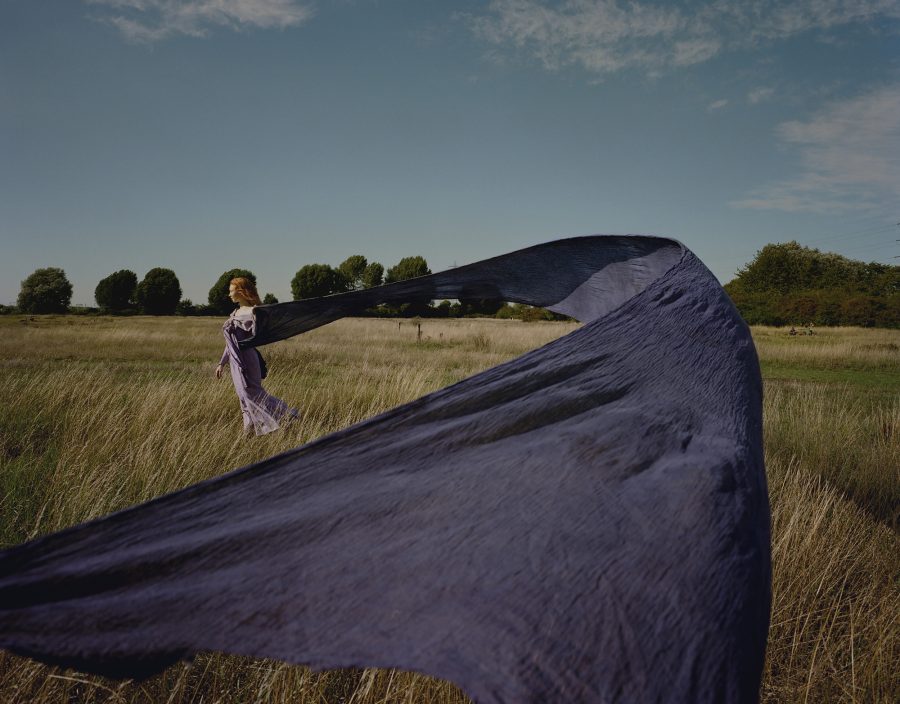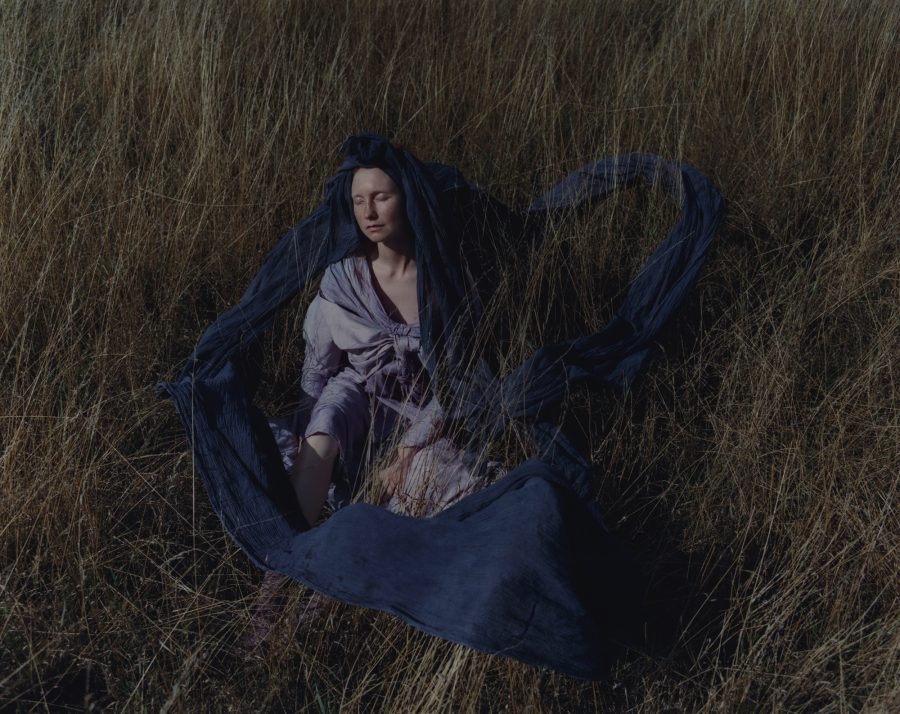To Exalt the Ephemeral
Feature 19.10.20
Photography Suzie Howell Styling, hand-dyeing and words Grace Joel Model Jessica Luostarinen
To pass the lonely and stifling days of lockdown, stylist and costume designer Grace Joel took to wandering nearby Hackney marshes where foraging led to hand dyeing and a new enriching creativity. Here she reflects on her journey and why we should cherish nature within our environment. Captured by photographer Suzie Howell, Grace styles the results of her colourful endeavours.

During lock down I started to go for long walks everyday to escape a cramped and uncomfortable flat share that had turned sour. I soon discovered Hackney Marshes, an untamed patch on London’s outskirts. As the River Lea forks, brambles and nettles grow rampant on wasteland sitting on top of the debris from the Blitz that drained the marsh. In a WWII bomb crater lies an overgrown pond surrounded by cattle in ancient grazing meadows, now dotted with humming electricity pylons. The area is littered with industrial remnants – the old aqueduct, reservoirs, filter beds, Victorian railway bridges; it’s a fascinating and eerie place.
In May we had the most incredible Spring, the sunniest on record. For the first time in the city we could hear birds sing, ducklings and cygnets traversed the paths, no planes disturbed the clarity of the infallible blue sky, which was visible with stars at night for the first time in memory. Breathing clean air and being able to have the time to appreciate the moment felt novel. The toxic river was full of people up to their knees in murky water enjoying life – you really learned to make the most of who and what you had around you. It was hard not to feel optimistic. While we were in the middle of a plague as a species, there was the underlying tension between walking in paradise and the awareness that we were dying.


Each day I would clock up the miles on various routes around the river and reservoirs and start to notice how the marshes would change from week to week. The wild yellow surge of tansy disappeared as soon as it arrived, as did the pink heather, the elder and blackberries exploding in July, followed by bursts of fluorescent orange rose hips and red hawthorn. I couldn’t believe how much was unnoticed and available right on our doorstep in Hackney; rocket, sorrel, horseradish, sage, mushrooms, thyme, fennel, yarrow, all with with culinary, magical and and medicinal properties. Near the railway lines, apple and pear trees and other strange species where commuters once threw their cores out of the train windows, sprouted in abundance.
I started collecting things on my walks and at night simmer and steep them on the stove, gently coaxing out colours. The alchemy of it some how acted as a grounding balm to the uncertainty. The joy sparked by finding a lone eucalyptus tree (to make red) in Millfields Park had me slightly questioning my own sanity. I dyed old sweaters, wedding dresses, anything pale I could find in my studio or cheaply on ebay. (Protein fibres like silk and wool take the pigment best). After many years of working in the ruthlessly fast paced fashion industry where you have to turn over multiple productions a week; developing a real connection over time to a project and learning to be patient felt very fulfilling. There is something very naive and therapeutic in the ancient process.

I started collecting things on my walks and at night simmer and steep them on the stove, gently coaxing out colours. The alchemy of it some how acted as a grounding balm to the uncertainty.

The area itself has a long history of textile manufacturing, the first ever synthetic dye was in fact invented in East London. Mauveine, was an accidental by-product created in the search for a cure for malaria in 1856 and soon made purple clothing extremely fashionable. Previously the colour was extracted from sea snails, a rarity reserved for royalty. It saw the rapid move away from natural dyes which had been used for centuries and democratised bright colours formerly only attainable for the rich. The River Lea was one of the most polluted in the country, and the fashion industry was and now still is the one of the most polluting in the world.


I spent the last year working on the costumes for a dystopian TV series based on Aldous Huxley’s Brave New World prophetically written in 1931. Huxley’s future society is conditioned to believe that “ending is better than mending”, constant newness and throw away culture is promoted as the only way to live. We constructed a “cellophane wrapped tomorrow” where the styles changed rapidly throughout the episodes, a world which in reality, we’ve sadly been living in for a long time now and will take many years to reverse. The process of working on a shoot where everything is bought for single use, shipped in swathes of plastic, only to be returned, (and in some cases burned as it’s cheaper than paying someone to check and replenish for resale) feels increasingly uncomfortable. Fashion shoots where samples are shipped internationally for a day for a photograph in order to sell it, no longer feels right or sustainable. There is such an interest in dystopian fiction and film now as people are really questioning how they want to live and the future of the planet.


I’ve been returning a lot lately to another piece of speculative fiction written by Marge Piercy in 1976, Woman on the Edge of Time. The book presented a very different kind of future; a feminist utopia, which is classless, gender-neutral, community based, making do with very little material possessions and encourages living off and respecting the earth. A resurgence in activities of repair like darning have gained massive followings on Instagram; Hikaru Noguchi’s videos of fixing socks and jumpers have a huge fan base and are immensely gratifying. Ceramics, quilting, baking, foraging, together coined “cottagecore” by the Tik Tok generation, has emerged as the most aspirational lifestyle of 2020. The collective mood for a slower, more simple life and DIY spirit feels optimistic and in a way, utopian.


The war time Make Do and Mend mentality of extending the life of clothes encouraging thrift, preventing wastefulness and teaching value of our belongings has new currency in the face climate change and looming recession, but also with unprecedented time on our hands this year, our previous lives of convenience and quick gratification really seem unnecessary and hopefully something of the past. The pamphlet originally issued by the Ministry of Information in 1943 has recently been republished for modern times.. Colouring your clothes is just another great way of up-cycling and giving them new life.
The beauty of natural dyes is their unpredictability. One harvest of nettles can yield a bright lime green, only a month later from the same patch, offer a sage grey. The pH level and hardness of the water, (very hard in London) has a big impact on the hue too. Kitchen compost can produce amazing saturated colours; onions, beets, cabbage, turmeric, black beans, however they are fugitive and fade rapidly. An old wedding dress and pillow case now act as a marker of how many avocados I ate in quarantine.
While the plant dyes aren’t as colourfast as synthetics, they gradually change over time and need good love and care, their ephemeral nature is what makes them living and special. I like the idea that a piece really marks a moment in time – the berries sprouting out of a bomb site that destroyed so many homes and lives in the past, picked in a global pandemic, dyed with rainwater collected from these skies that were clear for just a short moment.


Some resources to try it yourself!
Natural Dyeing is a very easy, cheap and sustainable process that just requires a lot of time and patience. Here are some of my favourite resources:
Instagram & Youtube
The Dogwood Dyer
The Natural Dye Works
Billy Nou
Rebecca Desnos
Plants & Colour
Upstate
The Wild Pigment Project
Books
Wild Colour: How to Make & Use Natural Dyes by Jenny Dean
Vegetable Dyes: A Book of Recipes and Information Useful to the Dyer by Ethel M. Mairet
Botanical Dyes at Your Finger Tips by Rebecca Desnos
The Modern Natural Dyer by Kristine Vejar



